 |
| 'White Amber' |
For any iris, winning awards is a matter of both worthiness and luck. Luck is always an element in the recognition equation: an iris might put on a particularly impressive display at an iris convention where many judges see it. Or it may put on a great show of bloom, but a week before the convention visit. It may have been planted on a rock, or at the corner of a sunless bed that missed water and fertilizer. In other cases, a worthy iris may never get to the convention for various reasons, perhaps there is not enough stock, for instance. Over the many years that we have sent Siberians to conventions we have seen all these things happen. We have also been lucky when an eye-catching plant showed itself off like a fashion model just as the visitors came. So here I would like to start a series that recognizes fine Siberians, that for one reason or another, never seem to have received the recognition they (to me at least) deserve.
 |
| 'White Amber' (Photo by Brock Heilman) |
I don’t understand why Marty Schafer and Jan Sack’s 'White Amber', introduced in 2001, has never received any AIS award; not even an Honorable Mention. Maybe they have so many good introductions that some just get overlooked in the crowd, but 'White Amber' for me is one of their finest. It grows very well for us, blooms early and reliably produces masses of bloom held so that the clump effect is near-perfect. The colors of the flower are novel and satisfying.
It comes from a complex background involving 'Reprise', 'Mad Magenta, 'Isabelle', 'Silver Illusion' and 'Snow Prince'. Surely 'Snow Prince' must have had a significant role because the flowers are relatively small, though compact and nicely ruffled, and the plant generally has a “sibirica” appearance. Maybe Isabelle helps with the yellow base. The color is perfectly captured by the name – a smooth, warm, milky amber color on the falls that comes from combining yellow and light lavender–pink and which intensifies towards the hafts. The standards are near white and the style arms are mainly yellow. It is certainly in the top dozen Siberians I would take if banished to that proverbial desert island.
It comes from a complex background involving 'Reprise', 'Mad Magenta, 'Isabelle', 'Silver Illusion' and 'Snow Prince'. Surely 'Snow Prince' must have had a significant role because the flowers are relatively small, though compact and nicely ruffled, and the plant generally has a “sibirica” appearance. Maybe Isabelle helps with the yellow base. The color is perfectly captured by the name – a smooth, warm, milky amber color on the falls that comes from combining yellow and light lavender–pink and which intensifies towards the hafts. The standards are near white and the style arms are mainly yellow. It is certainly in the top dozen Siberians I would take if banished to that proverbial desert island.
 |
Another in the characteristic of a great iris is that it is a fine parent. Again it seems 'White Amber' has been overlooked. The AIS Iris Register lists no named progeny. That is until this year when we introduced an iris called 'Lemon Mousse' which is from 'White Amber' x 'See Ya Later' (Hollingworth, 2006). That cross gave irises in a variety of colors and patterns with several being good enough to take to the next stage for consideration.
I used 'White Amber' because it had such pleasing growth and flowering habits and because I was interested in the combination of yellow and lavender or red shades in Siberians. 'See Ya Later' comes from that kind of background too. So it’s rather ironic that 'Lemon Mousse' has no trace of red. It opens light yellow and fades to pure white with a yellow heart. The flowers are larger than 'White Amber', but produced in the same profusion. Another iris in this cross (05R1B15) did show the lavender and yellow combination along with striking yellow style arms. This too would have been introduced if not for a bunch of white grubs that ate the roots off in a dry summer several years ago. That’s when we discovered that European Chafer grub populations were rapidly on the rise here in Michigan.
 |
| 10J13B3 (No. 1) |
 |
| 10J13B7 (No. 2) |
The results of this cross were so pleasing that I decided to do another similar one using 'White Amber' and our 'Gem Quality' (2008), a seedling from 'See Ya Later' x the yellow 'Smiley Face'. And again the results have been fascinating – tremendously varied and some quite surprising, with all flowering vigorously. Here are three of them The first, 10J13B3, in which red-violet is combined with yellow to give orangey shades (the photo is less than ideal I’m sorry to say), and the second one (10J13B7) combining blue-purple and yellow to give some brown tones on the style arms and falls, may not be so unexpected, but where did the third (and most interesting) one come from?
 |
| 10J13A1 (No. 3) |
So to me 'White Amber' is an under-appreciated gem. I still vote it for an HM every year though I suppose its time is now past. Irises are never technically out of the running for an HM, but not being listed on the ballot now is a killer. It seems that some irises just can’t get lucky, but if you want to add a fine Siberian to your collection, do keep it in mind.

I saw White Amber at the Aitken's garden and it was very eye catching. I am surprised it has no HM!
ReplyDelete